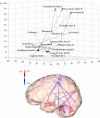Estimating brain functional connectivity with sparse multivariate autoregression
- PMID: 16087441
- PMCID: PMC1854937
- DOI: 10.1098/rstb.2005.1654
Estimating brain functional connectivity with sparse multivariate autoregression
Abstract
There is much current interest in identifying the anatomical and functional circuits that are the basis of the brain's computations, with hope that functional neuroimaging techniques will allow the in vivo study of these neural processes through the statistical analysis of the time-series they produce. Ideally, the use of techniques such as multivariate autoregressive (MAR) modelling should allow the identification of effective connectivity by combining graphical modelling methods with the concept of Granger causality. Unfortunately, current time-series methods perform well only for the case that the length of the time-series Nt is much larger than p, the number of brain sites studied, which is exactly the reverse of the situation in neuroimaging for which relatively short time-series are measured over thousands of voxels. Methods are introduced for dealing with this situation by using sparse MAR models. These can be estimated in a two-stage process involving (i) penalized regression and (ii) pruning of unlikely connections by means of the local false discovery rate developed by Efron. Extensive simulations were performed with idealized cortical networks having small world topologies and stable dynamics. These show that the detection efficiency of connections of the proposed procedure is quite high. Application of the method to real data was illustrated by the identification of neural circuitry related to emotional processing as measured by BOLD.
Figures














Similar articles
-
Analyzing the connectivity between regions of interest: an approach based on cluster Granger causality for fMRI data analysis.Neuroimage. 2010 Oct 1;52(4):1444-55. doi: 10.1016/j.neuroimage.2010.05.022. Epub 2010 Jun 1. Neuroimage. 2010. PMID: 20472076
-
Analyzing brain networks with PCA and conditional Granger causality.Hum Brain Mapp. 2009 Jul;30(7):2197-206. doi: 10.1002/hbm.20661. Hum Brain Mapp. 2009. PMID: 18830956 Free PMC article.
-
A graphical approach for evaluating effective connectivity in neural systems.Philos Trans R Soc Lond B Biol Sci. 2005 May 29;360(1457):953-67. doi: 10.1098/rstb.2005.1641. Philos Trans R Soc Lond B Biol Sci. 2005. PMID: 16087440 Free PMC article.
-
Bayesian networks for fMRI: a primer.Neuroimage. 2014 Feb 1;86:573-82. doi: 10.1016/j.neuroimage.2013.10.020. Epub 2013 Oct 18. Neuroimage. 2014. PMID: 24140939 Review.
-
Computational and dynamic models in neuroimaging.Neuroimage. 2010 Sep;52(3):752-65. doi: 10.1016/j.neuroimage.2009.12.068. Epub 2009 Dec 28. Neuroimage. 2010. PMID: 20036335 Free PMC article. Review.
Cited by
-
Persistent Homology in Sparse Regression and Its Application to Brain Morphometry.IEEE Trans Med Imaging. 2015 Sep;34(9):1928-39. doi: 10.1109/TMI.2015.2416271. Epub 2015 Mar 24. IEEE Trans Med Imaging. 2015. PMID: 25823032 Free PMC article.
-
Globally conditioned Granger causality in brain-brain and brain-heart interactions: a combined heart rate variability/ultra-high-field (7 T) functional magnetic resonance imaging study.Philos Trans A Math Phys Eng Sci. 2016 May 13;374(2067):20150185. doi: 10.1098/rsta.2015.0185. Philos Trans A Math Phys Eng Sci. 2016. PMID: 27044985 Free PMC article.
-
Improved dynamic connection detection power in estimated dynamic functional connectivity considering multivariate dependencies between brain regions.Hum Brain Mapp. 2020 Oct 15;41(15):4264-4287. doi: 10.1002/hbm.25124. Epub 2020 Jul 9. Hum Brain Mapp. 2020. PMID: 32643845 Free PMC article.
-
Measuring Granger causality between cortical regions from voxelwise fMRI BOLD signals with LASSO.PLoS Comput Biol. 2012;8(5):e1002513. doi: 10.1371/journal.pcbi.1002513. Epub 2012 May 24. PLoS Comput Biol. 2012. PMID: 22654651 Free PMC article.
-
Modeling time-varying brain networks with a self-tuning optimized Kalman filter.PLoS Comput Biol. 2020 Aug 17;16(8):e1007566. doi: 10.1371/journal.pcbi.1007566. eCollection 2020 Aug. PLoS Comput Biol. 2020. PMID: 32804971 Free PMC article.
References
-
- Albert R, Barabasi A.L. Statistical mechanics of complex networks. Rev. Modern Phys. 2002;74:47–97.
-
- Baccala L.A, Sameshima K. Partial directed coherence: a new concept in neural structure determination. Biol. Cybern. 2001;84:463–474. - PubMed
-
- Bach F.R, Jordan M.I. Learning graphical models for stationary time series. IEEE Trans. Signal Proc. 2004;52:2189–2199.
-
- Benjamini Y, Hochberg Y. Controlling the false discovery rate—a practical and powerful approach to multiple testing. J. R. Stat. Soc. B Methodological. 1995;57:289–300.
-
- Brillinger D.R, Bryant H.L, Segundo J.P. Identification of synaptic interactions. Biol. Cybern. 1976;22:213–228. - PubMed
Publication types
MeSH terms
LinkOut - more resources
Full Text Sources
Other Literature Sources
Medical
Research Materials

